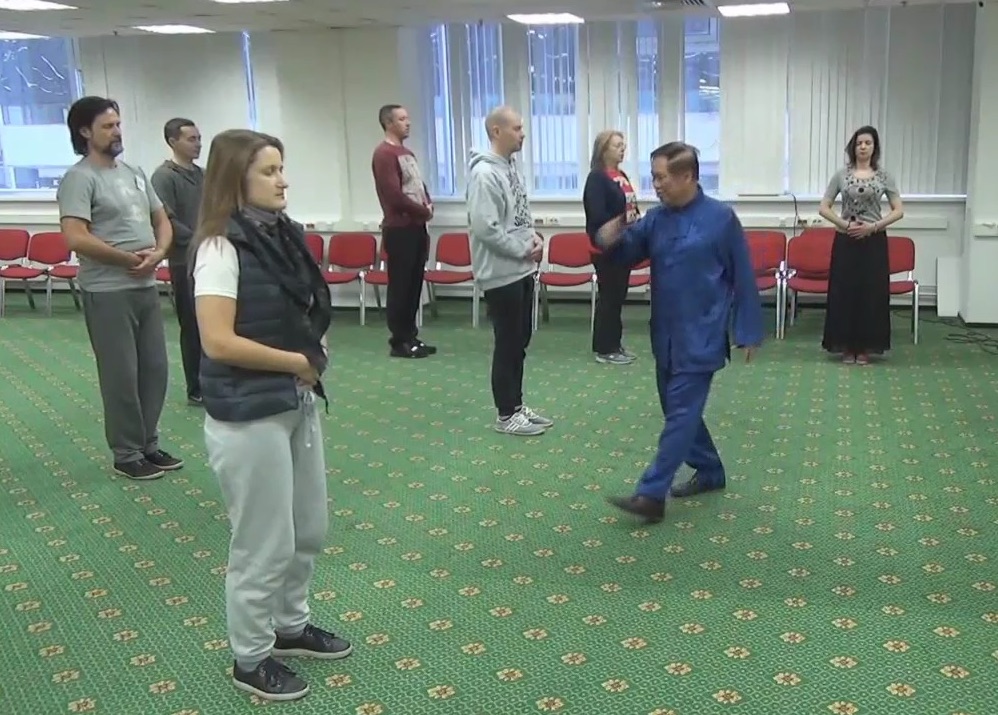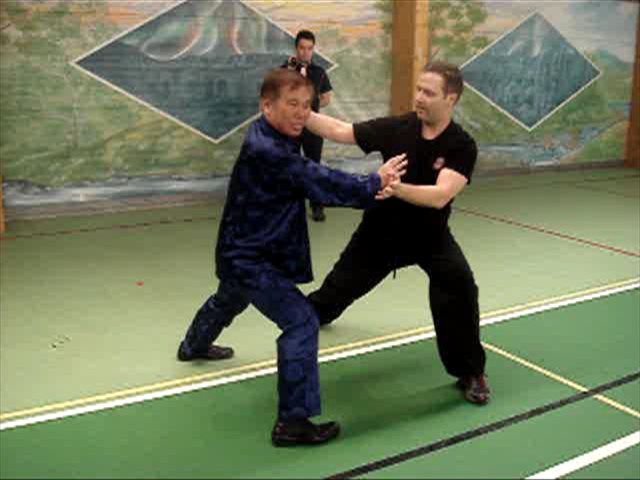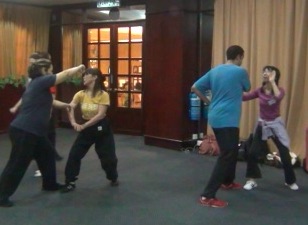SELECTION OF QUESTIONS AND ANSWERS
FEBRUARY 2019 PART 2

Practicing genuine chi kung gives good health, vitality and longevity
Question 1
Does practicing qigong give good health? I have been practicing qigong daily for a few years but I am still not healthy?
— Richard, USA
Answer
Yes, practicing qigong, which is often spelt as "chi kung" in English, gives good health. It also gives vitality and longevity as well as mental clarity and spiritual joys.
But it must be genuine chi kung. If it is not genuine, it will not give chi kung benefits like good health, vitality and longevity.
The above statement is straight-forward, but in the case of chi kung, it may need some explanation. Let us take an analogy. If you swim, you will have the benefits of swimming, like enjoying the recreation and will not be drown when thrown into water. If it is not genuine, like you merely perform some swimming techniques on land, it will not give you swimming benefits, like you will not enjoy the recreation of swimming and you may be drown if thrown into water.
Many people say they practice chi kung when they only perform some chi kung techniques. They do not have chi kung benefits because they do not genuinely practice chi kung, which is an energy exercise. They only perform chi kung techniques as gentle physical exercise. Most of them do not realize this fact, and they are actually nice people. As a rough estimate, about 80% of practitioners all over the world who say they practice chi kung, fall into this category.
So, the first step is to understand the difference between genuine chi kung and gentle physical exercise using chi kung forms.
The next step is to understand there are different chi kung attainments. For convenience we can divide the attainments into three levels -- low, medium and high. Low level chi kung is genuine chi kung but it takes a long time to attain a little benefits. High level chi kung takes a short time to attain a lot of benefits. Medium chi kung is in between.
Much of the genuine chi kung practiced today, i.e. out of the 20% of all practitioners who say they practice chi kung, is of a low level. Hence, the benefits may not be visible. For example, after a few years, when he compares his health now with what he was when he started chi kung practice, he can say he is healthy, but he may not realize it on a daily basis.
On the other hand, for high level chi kung, the comparison is noticeable. For example, he was sick before, but after a few months of daily chi kung practice, his sickness was overcome and he is now healthy.
Question 2
I am suffering from pain in lower belly due to foolishly using electrical impulse butterfly on my belly and since then I am suffering from pain in my belly, wheat allergy and frequent and painful urination not to mention constant and dull pain in abdomen all the times.
Since nobody is around in Pakistan to teach me, kindly specify what exercises to do to address my problem.
— S. Ali Nasir, Pakistan
Answer
It is skills and not techniques that are important in chi kung. More than 80% of chi kung practitioners in the world today practice gentle physical exercise using chi kung techniques. Hence, they cannot obtain benefits of chi kung, like overcoming pain and illness.
Skills have to be acquired from a master who knows them and is willing to teach you. I suggest that you attend my Intensive Chi Kung Course. You can find the dates of the course from my website.
No previous chi kung experience is necessary for this course, but course participants must follow and be abide by the Ten Shaolin Laws. You will need to practice at home what you have learnt at the course, especially on the first day. You have a very good chance to overcome your health problems.

Asking Bridge
Question 3
I love the idea of focusing the Asking Bridges course on sticking to the opponent no matter how he moves.
One of the problems I have encountered myself and that I have observed in some of my classmates and students, is that bridging and sticking is pretty easy to do when practicing sequences at various levels of the sparring methodology and both partners are staying relaxed while using their kung fu (even with a good threat level and speed).
Where it often gets tricky is when one partner uses a lot of movement and avoids bridging as a tactic (e.g. Choy Li Fatt, Monkey) or when one partner breaks through the other's guard non-decisively such that the other partner loses his cool and flails around a bit.
— Sifu Chris Didyk, Shaolin Wahnam USA
Answer
"Safety first", which includes covering your opponent adequately, is very important in all combat, not only in bridging. It is also a main principle many martial artists do not follow. You can easily confirm this statement by observing free sparring. The combatants merely exchange blows.
Controlling your opponent in bridging when he follows our combat sequences, is only the first step in bridging. The next step is to follow his footwork, without neglecting bridging. You need to practice this in advance. Imagine your opponent moves back a step, and you follow immediately. As soon as he settles down in his new stance, you already have followed him with your bridging intact. If he moves back faster, you follow faster.
Next, he moves back 2 steps, and you follow 2 steps. By the time he is settled, you are already ready to strike him if there is an opening, and usually there is an opening because he will usually neglect his defence as he will be concerned about settling down. At all times, you must be safe from his intended or unintended attack. In other words, you cover him adequately without giving him any chance to attack you even if he wants.
Then he moves back 3 steps, and you follow. Next, he jumps away, and you follow. The principle, "starting later but arriving earlier", should be observed. But even more important than this principle, is the principle of "safety first".
The third step in your bridging practice, after you can perform the first two steps well, is to maneuver your opponent's movement so that you can strike, kick, fell or grip him, of course without loosing your bridging and your "safety first" principle. The principle of "starting later but arriving earlier" is very useful.
Question 4
Sifu, thank you for taking the time to translate the book, Legends from Southern Shaolin and for posting it on the Wahnam website. It is riveting and I am glued to each story.
— John, Ireland
Answer
I am glad you like the legends of Southern Shaolin. These legends were popular among genuine masters and those who like kungfu stories of the older generation. It is good that our Family members know these legends too.

Legends of Southern Shaolin
Question 5
In the first story, Wang Chen Thong's manner in advance of his taking the Lei-tai seemed almost inevitable that he was underestimating his opponent and was going to his death at the hands of Looi Hoong.
Answer
Yes, Wang Chen Thong was underestimating his opponent, especially an opponent like Looi Hoong who was a good kungfu fighter. Underestimating an opponent is one of the faults a good kungfu exponent must avoid.
On the other hand, a good kungfu exponent must also be confident of himself, and put aside any fear of death if he wants to perform well. A scholar-warrior, a value we cherish in our school, must know that he will win in the combat. If he is unsure, he will not be engaged in the combat.
Times have changed. In the past, kungfu was for fighting. Today we practice kungfu for health, vitality and longevity, as well as to enrich our daily lives. Wang Chen Thong's manner in advance of his taking the Lei-tai seemed almost inevitable that he was underestimating his opponent and was going to his death at the hands of Looi Hoong.
Question 6
It is captivating to read how the warriors flew up onto the Lei-tai fearlessly without a thought for their safety, with a steely resolve to implement real kungfu in a life and death situation. Also, how they flew up onto the Lei-tai was also mesmerizing. Sifu, would it be laughable to aspire to the Art of Lightness at this early stage of my kungfu training?
Answer
It is certainly not laughable for you to aspire to the Art of Lightness at this stage of kungfu training. Actually your kungfu level is high and you can do well in the Art of Lightness. It will be wonderful to preserve this art. I was quite good while training the Art of Lightness when I was younger. But I discontinued because I realized it did not have many practical benefits. I prefer to take a lift or drive a car.
The Art of Lightness is probably one of the two arts that we are unable to perform like past masters. The other art is that of missiles, like secret flying darts and knives. We are unable to "attain a hundred hits without a miss" when sending missiles, nor to catch or avoid missiles when they are sent flying to us. We can't even send missiles. My sifu, Sifu Ho Fatt Nam, was quite good at missiles. My sigung was an expert.

A scholar-warrior is sure of winning even before combat
Question 7
Would it be fair to say that Looi Hoong (who undoubtedly was already a superb martial being) actually improving his skill with each battle-experience on the Lei-tai, meaning that now, after vanquishing Wang Chen Thong, his 20th opponent so far, he was harder to beat than when he first stepped on the Lei-tai on the first day it was raised?
Answer
I am not sure whether Looi Hoong was improving his skills at the lei-tai, because he was already a good fighter. In other words, before the lei-tai he already had improved his skills while he was a student.
Kungfu in the past was very different from kungfu now. Now, even "masters" cannot fight, and their students merely exchange blows or perform kungfu forms.
Given the present situations, our students will certainly improve their skills if they engage more in free sparring, especially when they use their combat sequences. The 30-opponent programme, which was the result of my free sparring and some actual fighting for about 20 years, is excellent.
Question 8
It is also interesting that Looi Hoong only employed leg-techniques after his desire to kill arose. Was this peculiar to how Looi Hoong fought or was it common practice for opponents to 'feel each other out' first with hand-techniques before employing their legs?
Answer
Using leg techniques was peculiar to Looi Hoong, as it was his ultimate art, but it was not common practice for other opponents.
Nevertheless, first using the hands to feel the opponent out, and also to cover and distract him, was common among good fighters. The way many modern combatants fight by using their kicks randomly, is asking for trouble if they meet a good kungfu fighter.
But good kungfu fighters are rare today. Even genuine kungfu is rare. Many so-called kungfu students merely exchange blows or just demonstrate kungfu forms.
LINKS
Selected Reading
- The Wonderful Benefits of Chi Kung
- From 30% to 95% Change of Winning Free Sparring Competitions
- Grandmaster Wong Kiew Kit
- A False Alarm
- Mule Ride
